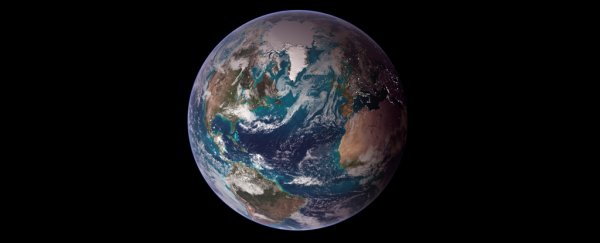Scientists are constantly learning more about the tectonic plates shifting across our planet's surface. According to new research, it turns out those plates have been around on Earth for longer than we originally thought – about a billion years longer, in fact.
These giant slabs of rock sit in the Earth's crust just above the mantle, and we can see the results of their shifting and crunching all around us, from the formation of mountain ranges to earthquakes and volcanic activity.
The new study is based on new geochemical models of the early Earth that use the element argon (Ar) as a measure. As argon is too heavy to leave our atmosphere, we can use it as a way of peering back in time through the planet's history.
Argon gas is released as part of continental growth caused by subduction (one plate pushing down on another), a key indicator of tectonic plate activity. As argon accumulates, it can be tracked back to the radioactive decay of potassium in the planet's crust and mantle, and then to tectonic movement.
"Our model is the first to investigate the full effects of crustal evolution, including both crustal recycling and reworking, on the degassing history of Earth," write the researchers in their paper.
Accounting for that crustal recycling (where crust gets eroded then carried back underground) as well as the creation of new continental crust was one of the key considerations for the researchers. Their model suggests the tectonic plate network was in place more than 4.4 billion years ago, way beyond most previous estimates.
Assessing the geological history of Earth is a tricky business though. We're not exactly sure what's happening in terms of tectonic activity today, let alone billions of years ago, but the argon measurements could be our best bet yet for dating tectonic plate movement.
"Because of the peculiar characteristics of argon, we can deduce what has happened to the solid Earth by studying this atmospheric argon," says planetary scientist Jun Korenaga, from Yale University. "This makes it an excellent bookkeeper of ancient events."
It's not the only piece of evidence that's come to light recently that tectonic plates have been in place longer than 3 billion years or so, which is the current understanding. Studies of magnetism in ancient rocks in Australia and South Africa have already been pushing the date back by a few hundred million years.
Peering back through time like this is an important way of figuring out just how life on our planet got started. The shift from molten, flowing rock to hard crust is a crucial one not just for the study of the early Earth but for early lifeforms too.
As the researchers behind the latest study note, we still don't have a definitive answer as to when this shift to tectonic plates happened – but the suggestion that they're much, much older than we thought is undoubtedly worthy of further investigation, no matter how challenging it is.
"Understanding when plate tectonics started on Earth has long been a fundamentally difficult problem," says Korenaga. "As we go back deeper in time, we have fewer geological records."
The research has been published in Science Advances.
